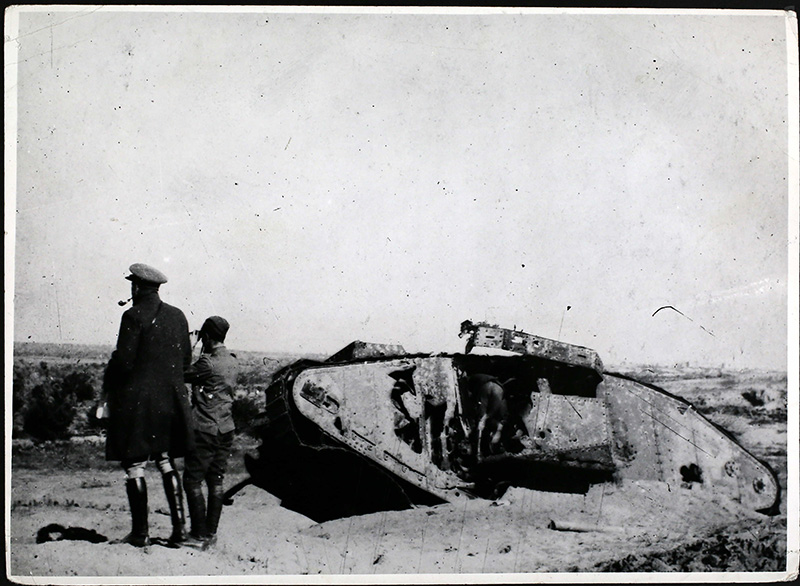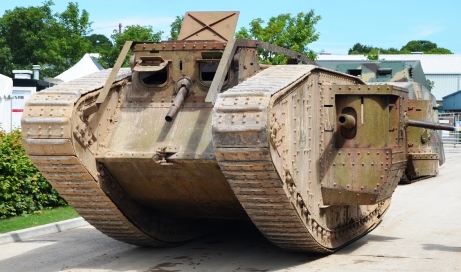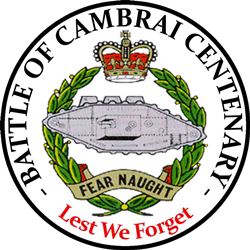Tuesday 20th November, 1917 at twenty minutes past six a solitary gun broke the silence. It was the signal, and from just North of Bapaume road to the hamlet of Gonnelieu in the south a long line of tanks crept forward into the fog. This was the day that tanks were used en masse for the first time in the history of warfare as the Battle of Cambrai Began.
All through 1917 the new steel ‘male’ and ‘female’ tanks were being produced in British workshops by the hundreds. They were being produced for a definite purpose. Sir Douglas Haig and his Staff knew exactly what they could do, and prepared to recognise and correct the mistakes in their former employment.
In the Somme campaign in September, 1916, the Tanks had been brought into action hurriedly before their Commanders and crew were properly trained. The useful work they did was not the full measure of their powers. They helped the offensive forward, but did not do as well as they might have done had the training of the crew been completed. In the snow and rain of the Arras battle the armoured cars had bad ground, and in the Messines Ridge attacks and in Ypres swamp battles they were not used in large numbers, for the reason that the terrain did not suit them. Thereupon, the studious and thoughtful German, unaware of all the facts of these case, came to the conclusion that the British commanders had no faith in the new British chariot of war, and merely continued to use it as a show piece to encourage the infantry. This was the ground upon which the surprise offensive at Cambrai was built.
On 20th November 1917, at 6.20am, the British Third Army attacked the German trenches at Cambrai without warning of any kind. No early hints, no obvious positioning of men and guns, no preliminary bombardment. Suddenly a wall of tanks, more than had ever been seen in one place at one time, drove straight towards the enemy lines. The Germans were beside themselves with terror. Whilst the approaching infantry felt positively invincible behind this legion of war machines, many of the enemy abandoned both positions and weapons in a panic, and emerged shaking with their hands held high. As a great victory was declared at the end of the day, bells all over England rang out in triumph.
Of course, it wasn’t as easy as all that. An immense amount of planning went into the attack, made all the more difficult because of the urgent need for secrecy. The defences of the Hindenburg Line were no joke, and the Allies would need every bit of help they could get to breach them. As detailed in ‘The Western Front Companion’ by Mark Adkin, to get to the first line of trenches the men would have to get through four belts of wire fencing, topped with regular projections, 10-12 yards wide and 3-4 feet high. These stretched 100 yards deep, and fronted massive trenches, dug very deep and over 10 feet wide in a bid to topple the very tanks they were facing. Once they got through that line, the Allies would have to do it all again with the line behind that, then a third time with an incomplete, but still formidable, line of support trenches. This meant crossing 6-8,000 yards worth of barriers.

High Command decided that a concerted attack would be needed to breach it, utilising infantry, artillery, aircraft, the cavalry, and last but definitely not least, every single tank available for action on the Western Front, all working in unison. Great cunning was needed to get these forces into position without word getting out to the enemy. False rumours were spread about planned attacks elsewhere, and false reasons given for withdrawing tanks from other areas (namely, winter training); they were then assembled at Wailly, 4 miles behind the line. The leaders of the various forces were not told of the plan until three days ahead of time, so that the likelihood of information being wormed out of captured Allied soldiers would be reduced. All movements were carefully concealed by camouflage or use of wooded areas, and took place under cover of darkness. Above all, a preliminary bombardment was ruled out as being far too obvious a signal of an impending attack.
Careful thought was given to the actual method of attack too. The aircraft were used mainly for reconnaissance, to scout the defences and allow the leaders to prepare for them. The tanks were needed first to crush the wire blocking the infantry, since there was not be a bombardment to help with this, then to give support to the troops in eliminating the enemy guns and combating active defence by the Germans. To that end, 476 tanks were assembled, including 378 fighting tanks and 32 specially adapted to cut and clear the wire. The crews of the latter war machines were carefully trained to deal with the wire, while the former practiced dropping fascines, or large bundles of sticks that could be used to partially fill the trenches, thereby making it less likely (though far from impossible) that the tanks would reach tipping point when crossing them.

They would be supported by a burst of artillery, planned to go off exactly on the hour of ‘Z-Day’, i.e. the start of the attack, and the infantry would follow behind the tanks. The main attack would be made by III Corps, who would aim to capture two crossings over the St Quentin canal. 5 divisions of the Cavalry Corps would then pour over the bridges to surround Cambrai, while IV Corps captured Bourlon Wood. Meanwhile, VI, VII and XVII Corps would make diversionary attacks.
The plan went off without a hitch, with the gains behind the Hindenburg Line being almost beyond the wildest dreams of the commanders, partly because of the meticulous planning, partly because the many of the enemy defenders in that section of the line had been sent there for rest and recuperation after the Battle of Passchendaele, and were very old, very young or physically and mentally weakened. However, the biggest impact came from the psychological advantage for the Allies, and disadvantage for the Germans, of having the mighty and numerous tanks fighting on our side.
The brilliant victory would not last, as is often the case in battle. As ‘The First World War in Photographs’ by Richard Holmes explains, 179 tanks were totalled on the first day by gunfire, difficulties with the terrain (mainly tipping into trenches, despite the fascines, or getting bogged down in Bourlon Wood) or uncomplicated breakdowns. Both surprise and psychological advantage were lost, and the Germans, who had unluckily been reinforced by the 107th Division, bringing with them five field artillery battalions, the day before the battle, summoned their courage and resources for a ferocious counter-attack. At the end of the Battle of Cambrai, the last of 1917, little had been gained by the Allies. Both sides had lost about 45,000 men; 11,000 Germans were taken prisoner, while the Allies lost 9,000 men; and the Germans regained most of their early losses. Still, some small gains in land were made, and many lessons had been learned. The Allied leaders had seen just how important the element of surprise was in battle, and how effective a co-ordinated and well-planned attack by multiple forces, backed up by a large number of tanks, could be. Perhaps this was the battle in which the strategic seeds which would eventually blossom into victory for the Allies were planted.
The Battle of Cambrai 1917 changed the whole face of warfare for ever and restored the hopes of the Allies. The long held stalemate war had ended.
“I would like to point out that the sudden break through by our troops of an immense system of defence has had a most inspiring moral effect on the armies I command, and must have a correspondingly depressing influence upon the enemy. The great value of Tanks in the offensive has been conclusively proved. In view of this experience, the enemy may well hesitate to deplete any portion of his front, as he did last summer, in order to set free troops to concentrate for decisive action at some other point” Sir Douglas Haig.
Tracking WW1 Actions and Troop Movements at the Battle of Cambrai 1917 (ORBATS).
Our specialist data team have been working to transcribe the official Orders Of Battle publications (ORBATS) that were published by His Majesty’s Stationery Office, also numerous official British War Histories of the Great War to help provide in-depth record of military operations and engagements by the Army. All this information is now available through our feature and we hope that this will give a great insight into the movements and actions of your ancestor.
Follow the Battle of Cambrai HERE:

